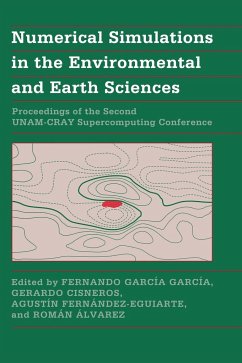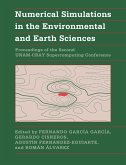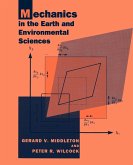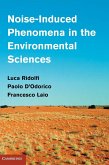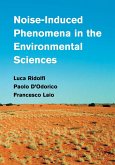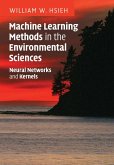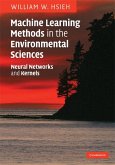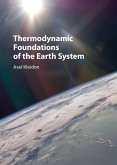Numerical Simulations in the Environmental and Earth Sciences
Herausgeber: García-García, Fernando; Fernández-Eguiarte, Agustín; Cisneros, Gerardo
Numerical Simulations in the Environmental and Earth Sciences
Herausgeber: García-García, Fernando; Fernández-Eguiarte, Agustín; Cisneros, Gerardo
- Gebundenes Buch
- Merkliste
- Auf die Merkliste
- Bewerten Bewerten
- Teilen
- Produkt teilen
- Produkterinnerung
- Produkterinnerung
Increases in computer power and technology have rapidly advanced the applications of numerical modelling in environmental and earth sciences. The progress of numerical modelling in atmospheric, oceanic and geophysical sciences was the topic of an international conference held by the National Autonomous University of Mexico. The review articles and research papers in this volume constitute a wide-ranging account of modelling environmental and earth processes through a variety of numerical simulations. Sections are devoted to such topics as general circulation models and global change, methods…mehr
Andere Kunden interessierten sich auch für
![Numerical Simulations in the Environmental and Earth Sciences Numerical Simulations in the Environmental and Earth Sciences]() Fernando García-García / Gerardo Cisneros / Agustin Fernandez-Eguiarte / Roman Alvarez (eds.)Numerical Simulations in the Environmental and Earth Sciences46,99 €
Fernando García-García / Gerardo Cisneros / Agustin Fernandez-Eguiarte / Roman Alvarez (eds.)Numerical Simulations in the Environmental and Earth Sciences46,99 €![Mechanics in the Earth and Environmental Sciences Mechanics in the Earth and Environmental Sciences]() Gerard V. MiddletonMechanics in the Earth and Environmental Sciences111,99 €
Gerard V. MiddletonMechanics in the Earth and Environmental Sciences111,99 €![Noise-Induced Phenomena in the Environmental Sciences Noise-Induced Phenomena in the Environmental Sciences]() Luca RidolfiNoise-Induced Phenomena in the Environmental Sciences147,99 €
Luca RidolfiNoise-Induced Phenomena in the Environmental Sciences147,99 €![Noise-Induced Phenomena in the Environmental Sciences Noise-Induced Phenomena in the Environmental Sciences]() Luca RidolfiNoise-Induced Phenomena in the Environmental Sciences47,99 €
Luca RidolfiNoise-Induced Phenomena in the Environmental Sciences47,99 €![Machine Learning Methods in the Environmental Sciences Machine Learning Methods in the Environmental Sciences]() William. W HsiehMachine Learning Methods in the Environmental Sciences47,99 €
William. W HsiehMachine Learning Methods in the Environmental Sciences47,99 €![Machine Learning Methods in the Environmental Sciences Machine Learning Methods in the Environmental Sciences]() William W. HsiehMachine Learning Methods in the Environmental Sciences110,99 €
William W. HsiehMachine Learning Methods in the Environmental Sciences110,99 €![Thermodynamic Foundations of the Earth System Thermodynamic Foundations of the Earth System]() Axel KleidonThermodynamic Foundations of the Earth System144,99 €
Axel KleidonThermodynamic Foundations of the Earth System144,99 €-
-
-
Increases in computer power and technology have rapidly advanced the applications of numerical modelling in environmental and earth sciences. The progress of numerical modelling in atmospheric, oceanic and geophysical sciences was the topic of an international conference held by the National Autonomous University of Mexico. The review articles and research papers in this volume constitute a wide-ranging account of modelling environmental and earth processes through a variety of numerical simulations. Sections are devoted to such topics as general circulation models and global change, methods of geophysical data assimilation, and mathematical and computational methods with geophysical applications. This book forms an excellent introduction and overview for graduate students as well as a critical update for researchers.
Produktdetails
- Produktdetails
- Verlag: Cambridge University Press
- Seitenzahl: 300
- Erscheinungstermin: 8. Februar 2016
- Englisch
- Abmessung: 260mm x 183mm x 21mm
- Gewicht: 763g
- ISBN-13: 9780521580472
- ISBN-10: 0521580471
- Artikelnr.: 21881472
- Herstellerkennzeichnung
- Libri GmbH
- Europaallee 1
- 36244 Bad Hersfeld
- gpsr@libri.de
- Verlag: Cambridge University Press
- Seitenzahl: 300
- Erscheinungstermin: 8. Februar 2016
- Englisch
- Abmessung: 260mm x 183mm x 21mm
- Gewicht: 763g
- ISBN-13: 9780521580472
- ISBN-10: 0521580471
- Artikelnr.: 21881472
- Herstellerkennzeichnung
- Libri GmbH
- Europaallee 1
- 36244 Bad Hersfeld
- gpsr@libri.de
Participants; Scientific committee; Organizing committee; Preface; Part I.
General Circulation Models and Global Change: 1. A general circulation
model of the atmosphere-ocean system; 2. Coupled ocean-atmosphere modeling:
computing and scientific aspects; 3. The OCCAM global ocean model; 4.
Climatic asymmetries relative to the equator; 5. On the use of a general
circulation model to study regional climate; 6. A numerical study of the
circulation and sea surface temperature of the Gulf of Mexico; 7. Pacific
region CO2 climate change in a global coupled climate model; 8. Prospects
and problems in modeling the impacts of climate change in Latin America; 9.
PIXSAT, a digital image processing system in a CRAY-UNIX environment; 10.
Marine productivity seasonal forecast along the Ecuadorian coastal zone
based on physical models of ENSO; 11. Land cover classification by means of
satellite imagery and supercomputer resources; Part. II. Dispersion and
Mesoscale Modeling: 12. Environmental applications of mesoscale atmospheric
models; 13. An integrated air pollution modeling system: application to the
Los Angeles Basin; 14. An h-adapting finite element model for atmospheric
transport of pollutants; 15. The applicability of a mesoscale model in the
Valley of Mexico during extreme air pollution episodes; 16. Mexico city air
quality simulations under different fuel consumption scenarios; 17.
Numerical modeling of pollutant particle diffusion in the atmospheric
boundary layer; 18. Investigating the dispersion inside idealized urban
street canyons using a k-epsilon turbulence model; 19. Coupling of an urban
dispersion model and an energy-budget model; 20. A mesoscale meteorological
model to predict windflow in the Valley of Mexico; 21. Some experiments
with a three-dimensional semi-lagrangian and semiimplicit cloud model; 22.
Large eddy modeling of stratocumulus clouds; Part III. Geophysical Data
Assimilation: 23. Computational aspects of Kalman filtering and smoothing
for atmospheric data assimilation; 24. Computational aspects of Goddard's
physical-space statistical analysis system (PSAS); 25. A study on the
influence of the Pacific and Atlantic SST on the northeast Brazil monthly
precipitation using singular value decomposition; 26. Numerically efficient
methods applicable to the eigenvalue problems arising in linear stability
analysis; 27. Use of canonical correlation analysis to predict the spatial
rainfall variability over northeast Brazil; 28. Identification of the ITCZ
axis by computational techniques; 29. Variational assimilation of acoustic
tomography data and point observations: some comparisons and suggestions to
perform error analysis; Part IV. Methods and Applications in Geophysics:
30. Do man-made obstacles produce dynamical p-wave localization in Mexico
City earthquakes?; 31. Domain decomposition methods for model
parallelization; 32. Parallelization using th-collocation; 32. A method for
simultaneous estimation of multiphase relative permeability and capillary
pressure functions.
General Circulation Models and Global Change: 1. A general circulation
model of the atmosphere-ocean system; 2. Coupled ocean-atmosphere modeling:
computing and scientific aspects; 3. The OCCAM global ocean model; 4.
Climatic asymmetries relative to the equator; 5. On the use of a general
circulation model to study regional climate; 6. A numerical study of the
circulation and sea surface temperature of the Gulf of Mexico; 7. Pacific
region CO2 climate change in a global coupled climate model; 8. Prospects
and problems in modeling the impacts of climate change in Latin America; 9.
PIXSAT, a digital image processing system in a CRAY-UNIX environment; 10.
Marine productivity seasonal forecast along the Ecuadorian coastal zone
based on physical models of ENSO; 11. Land cover classification by means of
satellite imagery and supercomputer resources; Part. II. Dispersion and
Mesoscale Modeling: 12. Environmental applications of mesoscale atmospheric
models; 13. An integrated air pollution modeling system: application to the
Los Angeles Basin; 14. An h-adapting finite element model for atmospheric
transport of pollutants; 15. The applicability of a mesoscale model in the
Valley of Mexico during extreme air pollution episodes; 16. Mexico city air
quality simulations under different fuel consumption scenarios; 17.
Numerical modeling of pollutant particle diffusion in the atmospheric
boundary layer; 18. Investigating the dispersion inside idealized urban
street canyons using a k-epsilon turbulence model; 19. Coupling of an urban
dispersion model and an energy-budget model; 20. A mesoscale meteorological
model to predict windflow in the Valley of Mexico; 21. Some experiments
with a three-dimensional semi-lagrangian and semiimplicit cloud model; 22.
Large eddy modeling of stratocumulus clouds; Part III. Geophysical Data
Assimilation: 23. Computational aspects of Kalman filtering and smoothing
for atmospheric data assimilation; 24. Computational aspects of Goddard's
physical-space statistical analysis system (PSAS); 25. A study on the
influence of the Pacific and Atlantic SST on the northeast Brazil monthly
precipitation using singular value decomposition; 26. Numerically efficient
methods applicable to the eigenvalue problems arising in linear stability
analysis; 27. Use of canonical correlation analysis to predict the spatial
rainfall variability over northeast Brazil; 28. Identification of the ITCZ
axis by computational techniques; 29. Variational assimilation of acoustic
tomography data and point observations: some comparisons and suggestions to
perform error analysis; Part IV. Methods and Applications in Geophysics:
30. Do man-made obstacles produce dynamical p-wave localization in Mexico
City earthquakes?; 31. Domain decomposition methods for model
parallelization; 32. Parallelization using th-collocation; 32. A method for
simultaneous estimation of multiphase relative permeability and capillary
pressure functions.
Participants; Scientific committee; Organizing committee; Preface; Part I.
General Circulation Models and Global Change: 1. A general circulation
model of the atmosphere-ocean system; 2. Coupled ocean-atmosphere modeling:
computing and scientific aspects; 3. The OCCAM global ocean model; 4.
Climatic asymmetries relative to the equator; 5. On the use of a general
circulation model to study regional climate; 6. A numerical study of the
circulation and sea surface temperature of the Gulf of Mexico; 7. Pacific
region CO2 climate change in a global coupled climate model; 8. Prospects
and problems in modeling the impacts of climate change in Latin America; 9.
PIXSAT, a digital image processing system in a CRAY-UNIX environment; 10.
Marine productivity seasonal forecast along the Ecuadorian coastal zone
based on physical models of ENSO; 11. Land cover classification by means of
satellite imagery and supercomputer resources; Part. II. Dispersion and
Mesoscale Modeling: 12. Environmental applications of mesoscale atmospheric
models; 13. An integrated air pollution modeling system: application to the
Los Angeles Basin; 14. An h-adapting finite element model for atmospheric
transport of pollutants; 15. The applicability of a mesoscale model in the
Valley of Mexico during extreme air pollution episodes; 16. Mexico city air
quality simulations under different fuel consumption scenarios; 17.
Numerical modeling of pollutant particle diffusion in the atmospheric
boundary layer; 18. Investigating the dispersion inside idealized urban
street canyons using a k-epsilon turbulence model; 19. Coupling of an urban
dispersion model and an energy-budget model; 20. A mesoscale meteorological
model to predict windflow in the Valley of Mexico; 21. Some experiments
with a three-dimensional semi-lagrangian and semiimplicit cloud model; 22.
Large eddy modeling of stratocumulus clouds; Part III. Geophysical Data
Assimilation: 23. Computational aspects of Kalman filtering and smoothing
for atmospheric data assimilation; 24. Computational aspects of Goddard's
physical-space statistical analysis system (PSAS); 25. A study on the
influence of the Pacific and Atlantic SST on the northeast Brazil monthly
precipitation using singular value decomposition; 26. Numerically efficient
methods applicable to the eigenvalue problems arising in linear stability
analysis; 27. Use of canonical correlation analysis to predict the spatial
rainfall variability over northeast Brazil; 28. Identification of the ITCZ
axis by computational techniques; 29. Variational assimilation of acoustic
tomography data and point observations: some comparisons and suggestions to
perform error analysis; Part IV. Methods and Applications in Geophysics:
30. Do man-made obstacles produce dynamical p-wave localization in Mexico
City earthquakes?; 31. Domain decomposition methods for model
parallelization; 32. Parallelization using th-collocation; 32. A method for
simultaneous estimation of multiphase relative permeability and capillary
pressure functions.
General Circulation Models and Global Change: 1. A general circulation
model of the atmosphere-ocean system; 2. Coupled ocean-atmosphere modeling:
computing and scientific aspects; 3. The OCCAM global ocean model; 4.
Climatic asymmetries relative to the equator; 5. On the use of a general
circulation model to study regional climate; 6. A numerical study of the
circulation and sea surface temperature of the Gulf of Mexico; 7. Pacific
region CO2 climate change in a global coupled climate model; 8. Prospects
and problems in modeling the impacts of climate change in Latin America; 9.
PIXSAT, a digital image processing system in a CRAY-UNIX environment; 10.
Marine productivity seasonal forecast along the Ecuadorian coastal zone
based on physical models of ENSO; 11. Land cover classification by means of
satellite imagery and supercomputer resources; Part. II. Dispersion and
Mesoscale Modeling: 12. Environmental applications of mesoscale atmospheric
models; 13. An integrated air pollution modeling system: application to the
Los Angeles Basin; 14. An h-adapting finite element model for atmospheric
transport of pollutants; 15. The applicability of a mesoscale model in the
Valley of Mexico during extreme air pollution episodes; 16. Mexico city air
quality simulations under different fuel consumption scenarios; 17.
Numerical modeling of pollutant particle diffusion in the atmospheric
boundary layer; 18. Investigating the dispersion inside idealized urban
street canyons using a k-epsilon turbulence model; 19. Coupling of an urban
dispersion model and an energy-budget model; 20. A mesoscale meteorological
model to predict windflow in the Valley of Mexico; 21. Some experiments
with a three-dimensional semi-lagrangian and semiimplicit cloud model; 22.
Large eddy modeling of stratocumulus clouds; Part III. Geophysical Data
Assimilation: 23. Computational aspects of Kalman filtering and smoothing
for atmospheric data assimilation; 24. Computational aspects of Goddard's
physical-space statistical analysis system (PSAS); 25. A study on the
influence of the Pacific and Atlantic SST on the northeast Brazil monthly
precipitation using singular value decomposition; 26. Numerically efficient
methods applicable to the eigenvalue problems arising in linear stability
analysis; 27. Use of canonical correlation analysis to predict the spatial
rainfall variability over northeast Brazil; 28. Identification of the ITCZ
axis by computational techniques; 29. Variational assimilation of acoustic
tomography data and point observations: some comparisons and suggestions to
perform error analysis; Part IV. Methods and Applications in Geophysics:
30. Do man-made obstacles produce dynamical p-wave localization in Mexico
City earthquakes?; 31. Domain decomposition methods for model
parallelization; 32. Parallelization using th-collocation; 32. A method for
simultaneous estimation of multiphase relative permeability and capillary
pressure functions.

